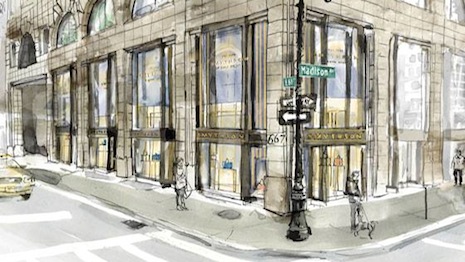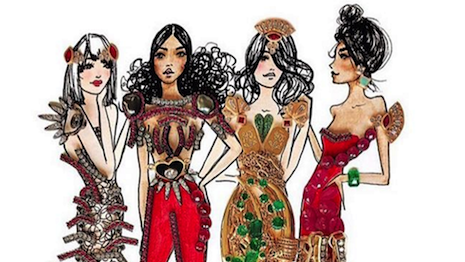Exclusivity, personalization and collaborations are the running themes that will make or break a British luxury brand within the next five years, according to WGSN.
A report commissioned by Walpole, titled "How to Attract the Luxury Consumer in 2020," compiled information from trends and experts, revealing that luxury brands should be leveraging tactics that focus on creating individualized, exclusive experiences while also partnering with other companies. Luxury brands that invest in these tactics now should have full-bodied strategy in connecting with the affluent consumer by the year 2020, at which time these pillars will become vital.
“In the digital space, with an ever increasing information and understanding of customer behaviour by way of real-time data and insight, brands have more connected potential to collaborate and create exclusive partnerships, content, experiences and products," said George Gill of GGMR. "Although synergistic collaborations are not a new concept, the levels to which such opportunities can be optimized and delivered upon digitally are staggering."
Making experiences
As the retail industry in general blossoms with digital experiences, many luxury brands may be forgetting the importance of in-store and exclusivity. While digital and mobile initiatives are vital, it will be those who master omnichannel that win out.
Luxury brands rely on their loyal customers, but to create loyalty marketers need to delve into personalization and exclusive experiences. Giving the most valued customers early access to a collection or tailoring notifications based on their purchase history can increase the opulence of the entire brand experience.
 Illustration of Smython's Madison Avenue boutique
Illustration of Smython's Madison Avenue boutique
For instance, brand exclusives will be 59 percent more likely to be beneficial towards consumers in 2010 and personalized notifications are 53 percent more likely.
In the past the industry was very straightforward, but as digital has emerged and startup culture has taken over, the game is different. Brands that collaborate with other brands, retailers or companies can give themselves an edge by offering something truly unique to customers.

Research shows that a relevant partnership will be 78 percent more effective.
Partnerships can range from a retailer collaborating with a brand for an exclusive collection to a company partnering with UberBlack for a special branded ride sharing experience. The idea is that the two brands must have relevancy, such as a luxury brand leveraging UberBlack, as the Uber division focuses on luxury transportation.
Technology research
Other research shows that digital media is expected to account for 27 percent of total advertising spend in 2016, according to new projections from global media network Carat.
The total expenditure on advertising is anticipated to increase 4.4 this year, reaching $548.2 billion for 2016, growing an additional 4 percent in 2017 to $570.4 billion. Carat’s forecasts show a positive outlook for the advertising industry, driven largely by the increasing resources put toward digital (see more).
“On the face of it, technology innovation in this space can be overwhelming and in many ways, vendor and integrator supplier choice can be something of a minefield,” Mr. Gill said.
{"ct":"200Az9A2r\/E1B+bvcTFOgMppoI8vaJrdWqE\/FdPlkWY1ByxtKpMbba2wpoLTosGQzso2+ng9xoBTZwZ03vhmu8v05YciowLRQs4v\/Bq2gxJ6wFf5VLsW6DO2OrWyDTaT0Pgek+bq80xCo69SnAjPSg3Dk5Kk4W1dylgo2nhYvZDjhMyBjwQYhdSGi\/nK8+cOLv9YUGmTh7PghkwXXlgGeYn7mp9fSMK\/gNw4512oyZ+H5+CIdbeh1u+PNQ0fzcQVO4in6W1\/ds07v9FkQwMHY9Mor2swhx0WBLvDuQPW23WwNXnpUpozEtdKz4noXvpZIjLidEUTgIJwVtScwDQ54EX\/0Bsv1Cp32uXGr0JxRNgu9poWCr\/kXBtLOAUbYhXdYDQLCIsRgBbzGzhligBhKxG1dPNLfCWfUscKbXKWVVGhjtEfJaO0M8fN2866alLtAaZJP3QMfyEgtoMn4DR9mJ1ldT\/3l3+XSQ7ppBzctSh3f3TigXuAit2\/9ZoU5j91bgnCpKGv3WiIW2+MXEugINt2DWFp+0g1j+NBE2cSmfAvMao6v6d26gq46IcYllHL7cV02+Dntc6tezE9E5WtTuI882st4kWuPgxF+Mol4O6T32kZDbYDhzexWr0C0wDSO79bOBOS0Hw87ixdkKcG4cxjekwxJVUzXjWJnq7T8LLEFLevxE5xqMv+C1YI3zRlgTwIq5+G5dSnJxjui4u0d\/vtEDOh9DAD0MGANLYDEWClwS8eggIRMabg7KvB76ShnffEnSnpQQEn1EyvFzXTBGB\/P2nTFqihnvk3qhtQ4ys2sxkMf4KohZxG4sy25yEuApupUQWAVTvz+2eYAieMpWwM1h758P5OnpH4tPa8yHcsU9qnXj0TiWfLwi7gvD9s4LdmLBUoM7WmYSKIuevz2poRvNHh6BaZeLIDM3aiCxnRjVzAwRM0LkfcAlYYP8Z+JYwIbENhbGuW2Le8AAnXsl+\/a3pO5UrBRb2WZg9c5xUo2FrFKuyRzN3DASD9Nqx8HXqprK929hFE62dhi13Ia\/HhofuDEsXGjpVDYtYd+wYobn7HP3Yjen1sJVS3YWCqbPgn5ha5izHAU31oDhMPgPRWcBxelyZ\/Sfiv6joFLWxVs8HNyxBFsJwYhd4AG3pIifSlh6UI4N0MW2g6ljdQYUP8WKcpbWRs2\/iLU9e87bJ8DOfUiwEe1xrhRx+r\/0yiz0eFFOOS\/X7jd2zV2JFP8zzj771QST5M83C9vARcQDVmeLNAGSH+G03euCgqDBbAAqrEZBADsKKT4r9HBpOY0V\/9oFdxQUPRWzh7P+wir6a\/wGuI5ZYtQ9ESlcskYxPvGZ78H0ToQhwSb1pplSOrh8TUCDmUz94zcukkfpVDMSPtYjORGvEevUIYx8jzR0ioMQE3x8aHIYAvfWC6dOSvmaeFkP4TnRY8Pr5KjYvid09G53aqZOm3EO\/JVuyANbCrkhkZUZFTk3\/BSDQhmftean+S9tlkiYknio33fMnKnh2rjvtNzJDVFLM\/L75VtRQSTU\/eT2YYl2f44F5RNKzByQ8wMxkECW9JV3LCrvhScb43fySbkRc9yGkq\/Ux1Fc8WvoLSttsygdCf3xqCoy7a7VwUFG4xNHPAb\/sD7luzFxJOtiJnnDDuXRmUubWHERLXraJZs2dDXztNemrSdnMaVwwUoQhovmx0nB+CNo0LhztaDpFG0ix1\/LzueubGr2V77jNanttrHXdmJHypq9VMNF5hyzngyp2nzDjLbSjyqlPXAkqa+xesSaSbjRuxISqz9BL3hZgjs5cVRbDAzNnwznckUuE8VQXBlIb0LKxdpHP1HzbnzemMCeRt5J8dTJu\/s6IO5ZsYF\/6a44x6HKys+rze+e8pkQQCRb6+pNS9uP8Y2rS\/02o+kPgAm+ZEt4SXyWIQ8xJb9zBRUScT1llYMkiwCtDVTYC6lYzYzOsH1i3yV\/pgWQdkez2JC2QyC7AZdJ+gkb0oWldL4DOTXXfTx2FctdUyWbmwjoGW3fDvwOmxXAT+ch7PFOjZ4YIFFHXqoiGzwgAf8aV9InN4AYfv52R\/GsiiBaRwEBk9aJLuM5IREI8p+\/F4b9qEo7N4uEXKnJcf+e9\/g6Vy4JmeOgTiovm+4kBqsvcmsjGZ2c7PKrgljO8DgpEOHlz+BoFo75Dazw0dE8AQ9jCVrTKW7r2hbEDGPREXxHSe2Wil\/RqbwAbFKEeu4iRoXgqgmRhzF3kFsSrO8Lq9PLIAMarqKgJmhNAlPOW16D6Esi3lF5qZQTan3r65IlY3LoO\/OXrLqw6BAZnHSyIJGtGjHKseUNqxk86jf66BbhxhyUXNgjqWNpyEZCefpi1cn9XBqtqmaS7iMCCQgBUXu9ZcisC6nv\/oAc7KNGNeQCiMyWXT0XgO9sA4MIZeJfve+aQoWwzNBE\/q1yW6CrV9XudlgzSZrTp\/1BXS6jc7ITDMRWeI\/gYAMfuPzL3sokpS3gxf5++sg\/7\/Szg7uPtX8HTkYlOrsiU83CAtonWjHeOCFhglCwsE8RmtY++5qW9Dkt\/DMJmqjWmoEXWmTMDZB\/KcHOpd8MR2DVajcjsGgQEn3yAv9gfBIw633DSFdPr6vuOeD31l4M06613vOZPSd2m\/QpWCd5leGopdHTEKXM5qzbjvv\/kdbkPrKQNNbmYuxwGb92QPccTbpoF0NYqH7WOiwaBne+BN3U0I+OoXj0GG4yin7XHjkX1NOix2De4sv54g6ALYNeglJms81ZwdLhGfuiC3wx+YzLWftco7SH6Z1PbsOWEQQm7SW3TZ5cy7grLV1nIWeqp4FdURcL6xQQA7m9hgPXyUXNxSy2SyJA9h2dVbd+o9jpA0LLDLP0Y4Hw\/grhz2INA1Qeyt7dgR9+OJLjXYBJpuRLqgj2C8FXnHmYxahmZNRS7HZMEXw28CdqI4Xi1scUxj7Wb1etviy5TNz3FwUabZQQlJxqh3snSSDAYUYzj1rjfRbyfUq\/6Gi4L9\/x5qF4ej+1duVV43ZzYHcKvHwRxnt\/BX5VgZEvwKBiMMekvnX6sTEi\/bvkaXtPbgEhHbgb6xO1lRIiyCUoJeRibHJlvW2wTBs9J9\/xhqR13fFH8I78otdn8P\/OioWtQiFw2GzB8HDht6Npmp4iU20t86my6P4WCp9VU06lxPCKaP5hnQDrMgQs+ZeSiYcBjr\/MfoCIaRlIm+\/hwzztF7wlKgpXYgBgNQM3Wb79jQJ7hfb+ZE9tc\/aOopTze5K4MMvA3FmfkWsqlkA3J7vX\/c5zT1RumOHoG7u4r9iopErG1oTzMxILZVqaPOC+9KEsBZOgZR9EfHsfSXinv6loNRYQbx\/70CGX6EDNAbyVRA4WqsSWGupSfgQFmaDmdscSYha+Az4PPVMSKXlpn7bRoaWYHfKrfggyR1zxZhv8r1iWJUT5VHYiJtmWrfra1ydBYYUAsGC+QFcAx38WjTqMwCeuCP0191Ac1D\/muOC7RHSph\/ujX\/y+PyLwoKWvH5AN2hUTw4E49DkbuPq8\/8KNXNdEc0cg95\/Eiicche6OXoSENYIWfme\/HFfLj4p0636xYxwpEY6md\/rtn+qleXVmnYyY2pscZtZ4Bvgc23WBzM7mIqo7Hz10UlcjMFkxo1V4SYRA4zLWf4wCyITwF+CpwO4CO\/xMJtj2QAS9gkC0E30xhXZEkWsyMEHdN0Eyu1DVf4VN1MqeBsdHIELYyJUK010SdjA6MALgakiaP92C6gg4Fw4Wy8sQWDGTHzc7SEad30bxQpIo4aRpkz96IhGIjdMjlfbya1gT3Z8OnYV+87BnY2Wyn8BsR39dnfTec4hqr5YaLo023OshZPbeWOBK\/axSFtS+7G8isHCTgh5nwRbR\/ZfoCN5bZ7VHeVn\/q8dNW35H38HDsaFdrQUgLAu5+mOs7yyq2pSMF87Yrd3b\/lM0r1Kn8joOBvzJ6EyZHg05zvm+0YGhIqwggCUMGMVL6LA\/jIur\/dyd82nwQ0sgE1AURjLmWMls2dBgNYPEkmuJvbDa6LbqaFn01d3J3AtNfeZvvcAORrP2nDTGx3EC9ieCIYQBfhTM7WX+PYl8xusMnhx30v14gL3E3j1Cwg9C\/DiEFIDWK9vPtdt4hkPPFH7g5IB9317gEhryDNuyJwohqJM09iJMq6FsAa6YTkelIMUSik+uhyHNrtzVuba8A1aa78YNqe368FF+7k6S58kXri47neXDxeDwfwXyMlCCRZYYuiO0VBFvzX2T8H1tWXVdLt8WJj\/+dlST2YEQbdfYZZAfyaqQzoGmc6dMIn+Nf7GwH+wq+Qe\/4g1wNowZsmNLUlOE0x3as+B6SjHEhkzV7zpsS\/2bJRXSCAvN4LlmhhANPhYeQHmlpKvN1Zn03P8H05Xy6sAUyr7bynKTRvHYETWU6II1VwEUpf8k\/IRVC5lWz8cHAo2X31E1PwCFb\/I0Nmk9n1t7qsx5clOdHoLjFUWKDPA7vdbcqfojFJ7t97frDM68Jvj6eY4l8AJcDxIgZ6MucOo7moOwxDcGNNkJF10jTsKzm7iNMqBKuTPkcWiNE09oZQkfO+qgSNdznxRVLTfuAc4m8M4\/RHGWrnIoLiNcFk5YAg6KSssxysvJV+bREcN2HWz0Ut95Qv+uJPsudDZ23rkD4\/tX2Gk97GXo7IOEV\/pG2g2Q\/MEqnMGG00b1tM+K0F5e\/sWr7h00ym1xwYU49GXohbcUV6fZXxLgrma9HffM43qiYBRbCTbMByd\/Y3a5IUomR9jq6FeuhQlUqwKzru+++AK1hcY3XrKW6h8iZqXae9PCfp6Ysqm77QMHfE0r1+JAqw54B6JKFKLCw3M+9rKosd\/0E2nzm6YpOQNa8PGucCwHhDZNBbrinc6P3mbgqSRW93NPOMQqQikiAHrriQCf2gIAm+4FOH4xH8hbQttfMGIhKKz5iyK1rvaWzgYVxnBNO5RjZE59MLQVw2FRKqYoYcwcBr\/PPWBvG4WZ1HbBjpbiLHXg4NssNvaJaqo7IOKTBVuWUT7e4YVA51GiySnBUOR5vVIv2OF1w4kFyS\/zP63GNgZjyN63rdGYcyk7fBihmXcB9L1kHYmICjuYWHFXnIshrOyKEX8Hnbkwz\/+HlhphHSIA+imLTxHGmZ+GWzhjBFUJsZiW77BvGEr+i9SezQivRtMhxoFQjAuKehVsaKIwsj2yqeMcdtv+FOjS7Qu5EtdcN0ZChGaMLkv+LB7otoQPokC9phV8Fdvk42EGYAqxYYouxX38Hoyv1MpGiLBSlqNLm8W8yO\/VQiTK32lCyWvdDkBtajtbJS3HIMeYJeatv3giv5l80q+uQEecaqubWnDUGuxKExZow1Lf4DrOZAQpm+hLG8YkLXMZqJlXXUBKk2KHbEvZ5TDMm8v0sJYA9HNogGuxa\/eGf+BXjfdW0CU4n\/cUpOuJArkkWmcgwM2asW4PofGaudMCgRnMt31uKcmFeqNwvK+\/NvoeeHv3uQap\/pII9PWx4W6+mTnodZUKVwISqP8xtrW+EVZBP4yj5n6IZ9JSKor5JjtpFU4v7M9APNwSpeUycGJJkUYoJWqwKDprnhV8rwBwQeX0K3koZf42WWWzvRAiDQQjAOl87h+4vqqVdXLotFlb8ktBrOd3ZV0+gZkpFpUpgdis\/qikZxs3lomMX8Sr3hCOiOjsv9PGLEilttPMAU39QlPyvHCE+MwFNVvwIiSsJvGM0NAjvNKqWFuaplqLYrCh\/r0YNqz21fDTxZ+ZGxjQRrnRxqsQGbxAzfTFsWf93ycQe55vsmftHAZr998ThajHdtxYj0Hr21wP3jbg661nkL6J8aexR7f15Pq\/w9Tfkr3\/masidVFrmpcJVzZSz7cl6X04vP7EhjbZD7MrqVKa3YlHOI","iv":"27a22ced8b4bfac8c7dc2e6e924c2ec9","s":"5b545301866e1d66"}

 Illustration for the Gemfields x Muse collaboration
Illustration for the Gemfields x Muse collaboration
 Illustration of Smython's Madison Avenue boutique
Illustration of Smython's Madison Avenue boutique